
2020.08 Iriomote Island and Yanbaru—Biodiversity Hotspots in Japan’s Southern Ocean
Iriomote Island—primeval forest, mangrove swamps, and endemic flora and fauna
Iriomote Island is the largest island in the Yaeyama island chain, around 400 km (about 250 miles) southwest of mainland Okinawa. The remote island is a sanctuary for many plants and animals, with virgin forests, rivers and mangrove swamps supporting a rich diversity of life. Visitors can access the island by ferry from Ishigaki Island.

Iriomote Island is dominated by dense forest
The island’s remoteness means its animal and plant life has evolved undisturbed for centuries. Many of its animals are extremely rare, including the Iriomote cat—the island’s apex predator.
Exploring Iriomote by canoe
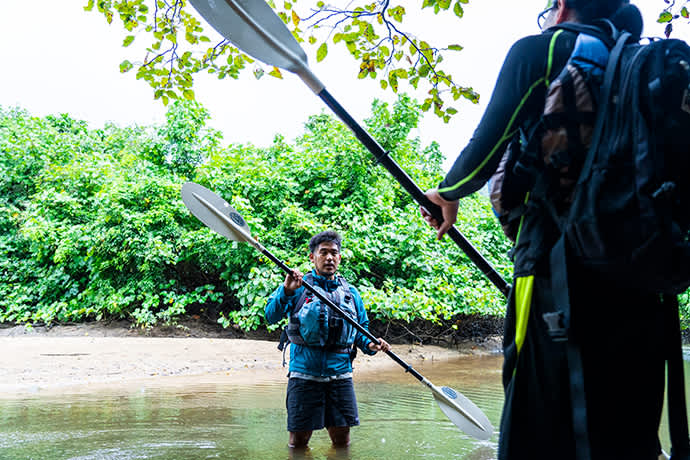
English-speaking tour guide Takafumi Hoshi teaches visitors some canoeing basics
Takafumi Hoshi, an English-speaking tour guide from the Kazaguruma tour company, is highly knowledgeable about Iriomote’s ecosystems. He recommends visitors head to Pinaisara Falls to understand more about the island’s biodiversity. “We get a lot of rain in Iriomote,” Takafumi explains, “and it floods down from the mountains to nurture the forests and rivers. The rivers carry nutrients through brackish estuaries and tidal flats to the sea. Within this expansive natural cycle, food and sustenance are easy to come by, explaining why the island is so full of life.”
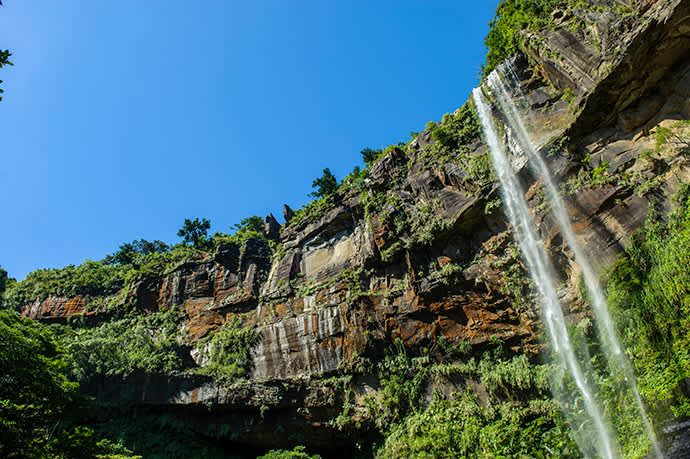
Pinaisara Falls. “Pinai” means “goatee” and “sara” means “to hang down” in the Okinawan language
Pinaisara Falls is one of the tallest waterfalls in Okinawa, with a drop of 55 meters (about 180 feet). It is located at the foot of Mt. Tedo in the north of the island. Visitors can access the falls by kayak along the Mare River, where the journey passes through mangrove forests and other natural features. The Mare River leads into the Hinai River, which runs up to the falls. Kayakers disembark before trekking along an unpaved road through the jungle to reach Pinaisara.

The brackish water supports creatures including stingrays and sea snakes
Kayakers paddling through the mangrove forests will spot three species of tree that can be differentiated by their roots. Takafumi explains: “The root shape is what distinguishes them. Yaeyama hirugi has a series of thin branches and pillar-like roots supporting the trunk, ohirugi has knee roots and mehirugi has sturdy, buttress roots.”
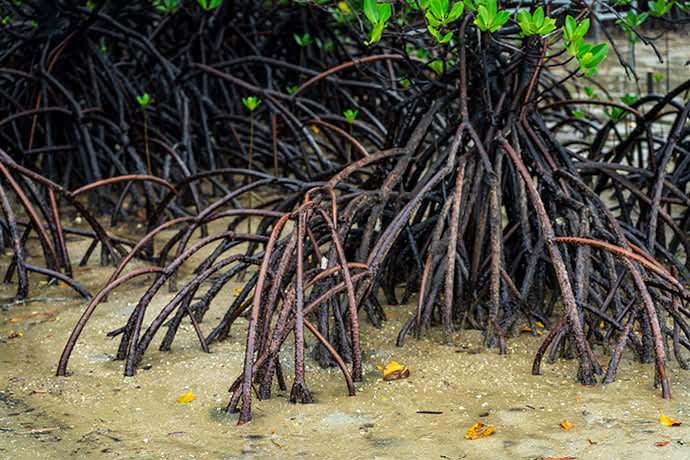
The thin, branch-like roots of the Yaeyama hirugi mangrove work to filter out the salt from the brackish water
Takafumi suggests that visitors consider traveling to the island in spring. “The Iriomote mountains are much hotter and more humid than many people expect. In this regard, summer isn’t an ideal season to visit. However, late March to the end of April is cooler, and there tend to be fewer visitors.”

A summer trek to the falls can be challenging—even for tour guides
Trekking through the jungle may reveal some of the island’s rare species. The Yaeyama yellow-margined box turtle lives in the jungle and is native only to Ishigaki and Iriomote islands. The turtle is listed as endangered on the IUCN Red List. Along with the island’s other endangered species, the turtle would benefit from the increased protection that a UNESCO World Heritage designation listing brings.

The box turtle resembles a box when it retracts its head, limbs and tail inside its shell
The brilliant green Sakishima grass lizard is another jungle dweller. It is endemic to the Yaeyama Islands and listed as endangered on the IUCN Red List.
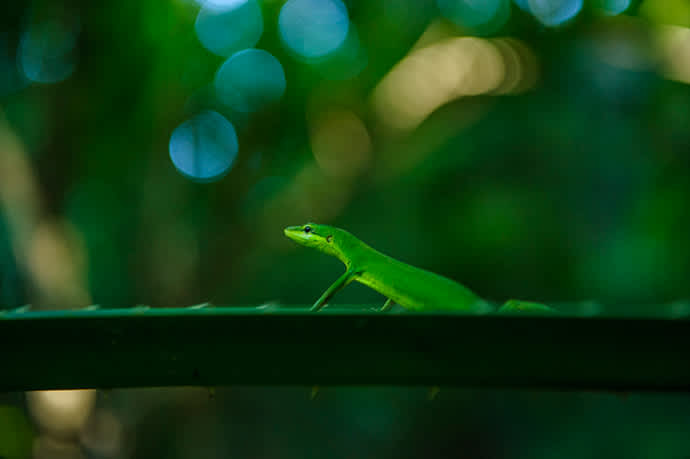
The endangered Sakishima grass lizard is native to the Yaeyama Islands
The trek through the jungle to the top of Pinaisara Falls takes around 50 minutes, including a short break. From this vantage point, visitors can view the ocean, spot the other islands in the Yaeyama chain and look upon the jungle and rivers that spread out beneath the falls.
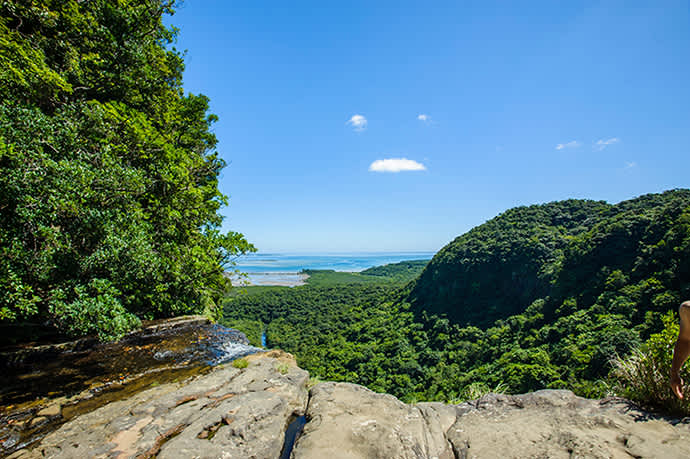
Hatoma Island, Barasu Island (formed entirely of coral) and the uninhabited Hatobanari Island are visible from the top of Pinaisara Falls
The tour leads back down the mountain to a waterfall basin, a further 20-minute trek through the jungle. It is a popular spot for visitors to take a dip and cool off.
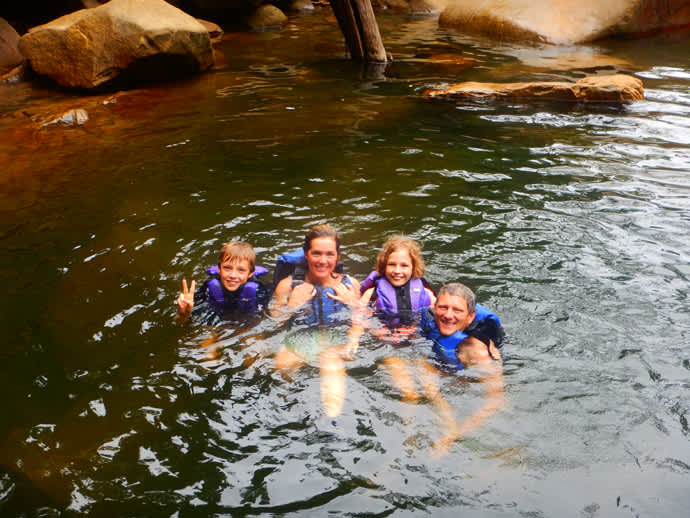
Kazaguruma’s Pinaisara Falls and waterfall basin tour departs at 9 a.m. and takes around 6-7 hours. The tour is open to ages 6 and over. Photo credit: Kazaguruma
Kazaguruma offers a range tours, including a 7–8-hour trek to Mayagusuku Falls or a snorkeling trip in the Funauki and Amitori areas, which are only accessible by boat. While global travel is currently severely restricted, Kazaguruma, along with other local groups, hope to share the beauty and importance of Iriomote Island with visitors when it is safe to travel again.
Iriomote Island—conservation and preservation
Conserving Iriomote’s ecosystems and biodiversity is the main impetus behind the island’s push for World Heritage status. Local communities are strengthening their conservation efforts to achieve this goal.
Tour companies are collaborating to combat the threat of overtourism by limiting the number of people who can visit a site at any one time. Authorities are also considering restrictions on unaccompanied trekking through the forests. These rules and regulations are likely to increase as conservation of the island’s natural resources become an even higher priority.
Conservation and preservation have influenced island policies and infrastructure. The local government built underpasses to ensure safe animal crossings, installed roadside gutters to prevent small creatures falling down onto the road surface, and instituted an island-wide speed limit of 40 km/h.

Roadside gutters (left) and a warning to drivers about Iriomote cats (right)
Road signs warning drivers to watch out for Iriomote cats are common around the island. The cat is nocturnal and can sometimes be spotted on the road at night while hunting for prey. Numbers of the rare cat have been declining, in part due to traffic accidents, and only 100 or so are thought to be still alive. A World Heritage designation would bolster the efforts being made to secure the Iriomote cat's survival.
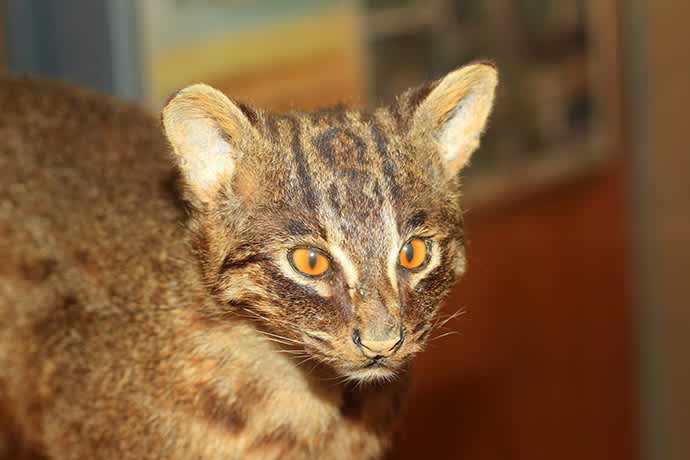
The Iriomote cat is listed as critically endangered on the IUCN Red List
Iriomote food culture and a resort stay
Iriomote Island’s culinary culture is centered around local ingredients. Traditional dishes include meats such as goat and Ryukyu wild boar, along with stir fries and braised pork dishes. Guests at the Hoshino Resorts Iriomote Hotel in Iriomote-Ishigaki National Park can taste many of these dishes in their restaurant.

Ryukyu wild boar hamburgers and paella with goat meat. Photo credit: Hoshino Resorts
Iriomote Hotel, operated by the luxury Hoshino Resort chain, was designed with both guests and the environment in mind. To conserve energy, guestroom temperatures are regulated to match that of the island. Lighting can be dimmed so that guests can enjoy views of the star-filled skies, and the day beds offer opportunities to unwind by listening to bird calls and crashing waves.

A spacious, deluxe twin room (left) and the hotel restaurant (right). Photo credit: Hoshino Resorts
Visitors to Iriomote Island can enjoy a wide variety of marine sports. The ocean is home to more than 400 species of coral, making it the perfect place to snorkel. Alternatively, SUP (stand-up paddleboarding) at sunset makes for a memorable experience.

Snorkeling is popular at Ida Beach, one of Iriomote Island’s most beautiful stretches of coastline. Photo credit: Hoshino Resorts

A SUP experience at sunset. Hoshino Resorts Iriomote Hotel offers a range of programs for its guests. Photo credit: Hoshino Resorts
The Yanbaru area is dominated by a dense forest full of life
Yanbaru is a large forested area on the main island of Okinawa. It is currently (2020) under consideration for a UNESCO World Heritage Site as part of the Amami-Okinawa bid. A rare evergreen forest dominates the Yanbaru forest landscape. Much endemic flora and fauna live under the canopy, some of which are endangered. Conservation efforts are critical to the survival of the individual species’ and the forest; therefore, becoming a World Heritage Site would be another positive step.
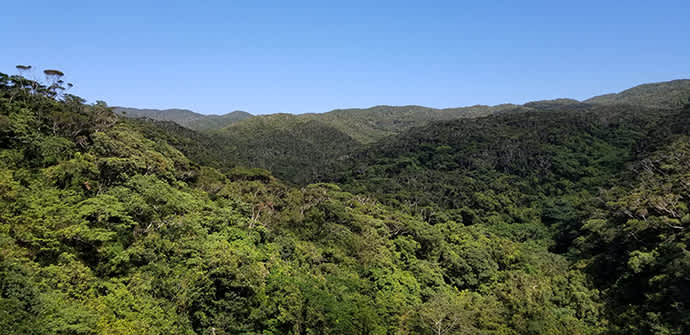
Yanbaru is dominated by a large evergreen forest—a phenomenon in a subtropical climate. Photo credit: Kunigami Village Tourism Association
The Yanbaru area is around a 2-hour drive from Naha Airport, Okinawa’s main airport. The Yanbaru forest covers around 136 square kilometers (13,600 hectares), and heavy annual rainfall helps maintain the forest’s ecosystems. The endemic species that live here include the Okinawa rail. This near-flightless bird is listed as endangered on the IUCN Red List.

The Okinawa rail is only found in the Yanbaru region. Photo credit: Kunigami Village Tourism Association
A trek to the summit of Mt. Yonaha
The Ministry of the Environment took steps to support the preservation of Yanbaru in 2016 by designating the area a national park. This recognition of the area’s natural value led to new rules and restrictions to protect the environment. Some of these regulations included regular forestry road patrols and the implementation of a certified guide system. Yukinari Yogi, one such guide, runs English-language tours in Okinawa and recommends visitors trek to Mt. Yonaha (503 meters (1,650 feet))—the highest peak on the Okinawan mainland.

Yukinari Yogi (left) is a certified guide and Yanbaru local. He runs the Okuma Beach Villa guesthouse on Okuma Beach. Photo credit: Kunigami Village Tourism Association
The trek to the summit of Mt. Yonaha takes around two hours. Visitors begin at the entrance to Yanbaru National Park and walk the mountain path to the peak. The trek offers visitors the chance to view much of Yanbaru’s flora and fauna, including many tree species including Itajii evergreen trees, which make up around 70% of the Yanbaru forest, and flying spider-monkey tree ferns.

A budding Itajii evergreen tree. Photo credit: Kunigami Village Tourism Association
Lumber from Yanbaru has long been used by builders to develop Okinawa. Inumaki trees from Yanbaru, also known as Buddhist pines or fern pines, were used to build some of the most prestigious buildings on the island, including Shuri Castle—the grand palace of the Ryukyu kingdom. Inumaki trees were often used for construction because of their resistance to termites and water.
The forests on Mt. Yonaha support many rare animals. One of them is the Okinawa rail—a small, near-flightless bird that is only found in the Yanbaru area. The bird was first discovered on Mt. Yonaha in 1981 and subsequently registered as a new species. Other rare birds that visitors might spot on the trek include the Okinawa woodpecker, a critically endangered species found only in Yanbaru. Insects thrive in the forest, and there are thought to be more than 3,000 species native to Yanbaru.
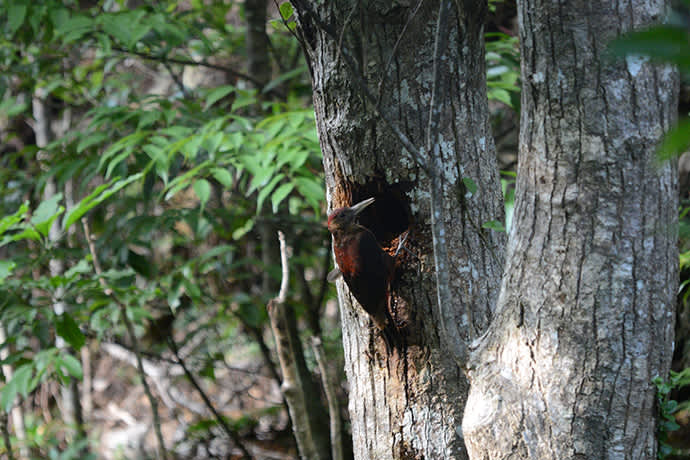
The Okinawa woodpecker is a critically endangered species—it is estimated that only around 90 individuals remain. Photo credit: Kunigami Village Tourism Association
The expansive Yanbaru area has many natural features to explore beyond its forests. Uppama is a beautiful beach on the east coast, Cape Hedo is at the northern tip of the island, and Kayauchi Banta offers views of the cliffs and oceans from an observation deck.
Aiming to become one of Japan’s UNESCO World Heritage Sites
Iriomote Island and Yanbaru are aiming to gain World Heritage Site designation from UNESCO. A world heritage-listing would likely lead to greater protections, safeguarding the rich biodiversity. As of summer, 2020, Japan has 23 World Heritage Sites. These spots showcase the country's history and nature. They range from wild and rugged Shiretoko National Park in the northern island of Hokkaido to the quaint traditional villages of Shirakawa-go and Gokayama.
Iriomote Canoe Tour Kazaguruma |
Hoshino Resorts Iriomote Hotel |
Kunigami Village Tourism Association |
Iriomote-Ishigaki National Park |
|
WEB: https://www.japan.travel/national-parks/parks/iriomote-ishigaki/ |
Yanbaru National Park |




















































